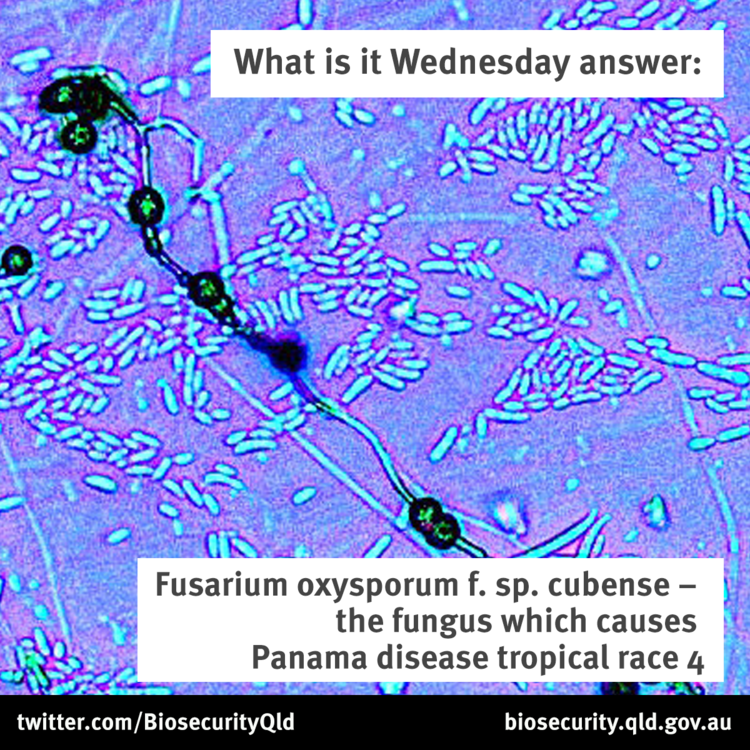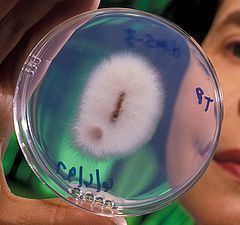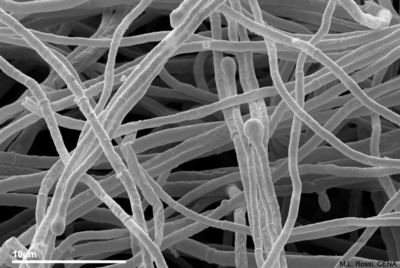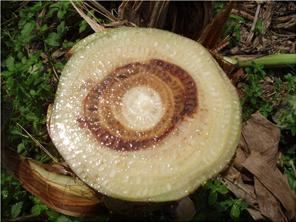Kingdom Fungi Rank Forma specialis | ||
 | ||
Similar Fusarium oxysporum, Fusarium oxysporum fsp lycop, Haematonectria haematococca, Rhizoctonia solani, Trichoderma | ||
Panama disease tropical race 4 identifying and reporting suspect plants
Fusarium oxysporum f.sp. cubense Pronunciation is a fungal plant pathogen that causes Panama disease of banana (Musa spp.), also known as fusarium wilt of banana.
Contents
- Panama disease tropical race 4 identifying and reporting suspect plants
- Overview
- Description
- Symptoms
- Management
- Research
- References

Overview

Although fruit of the wild bananas (Musa spp.) have large, hard seeds, most edible bananas are seedless. Banana plants are therefore propagated asexually from offshoots. Because these rhizomes are usually free of symptoms even when the plant is infected by F. oxysporum f. sp. cubense, they are a common means by which this pathogen is disseminated. It can also be spread in soil and running water, on farm implements or machinery.

Panama disease is one of the most destructive plant diseases of modern times. It is believed to have originated in Southeast Asia and was first reported in Australia in 1876. By 1950 it had spread to all the banana-producing regions of the world with the exception of some islands in the South Pacific, the Mediterranean, Melanesia and Somalia.

Panama disease affects a wide range of banana cultivars; however, it is best known for the damage it caused to a single cultivar in the early export plantations. Before 1960, a total reliance was put on the cultivar 'Gros Michel', and it supplied almost all the export trade. It proved susceptible to the disease and the use of infected rhizomes to establish new plantations caused widespread and severe losses. Some indication of the scale of the losses is demonstrated by the complete eradication of production on 30,000 hectares of plantation in the Ulua Valley of Honduras between 1940 and 1960. In Suriname, an entire operation of 4,000 hectares was out of business within eight years and in the Quepos area of Costa Rica, 6,000 hectares were destroyed in twelve years.

By the mid-1900s, resistant cultivars in the 'Cavendish' subgroup were being used as a substitute for 'Gros Michel' in the export trade. These cultivars have proved resilient and grow well in the western tropics, remaining the clones on which the current export trades are based. Unfortunately, in several growing areas in the Eastern Hemisphere these cultivars are susceptible to the disease. It is considered inevitable that this susceptibility will spread to the Western Hemisphere, and this poses a significant threat to production because there are currently no acceptable replacement cultivars. To make things worse, this variant of the pathogen also affects plantains, Musa acuminata × balbisiana, which are an important staple food in tropical regions of the world. The average American eats 26.2 pounds of the Cavendish banana each year and the question is being asked as to whether this oft-consumed fruit is on course to extinction.
Apart from the export trade, 85% of banana production is for local consumption and many of the cultivars used for this purpose are also susceptible to infection.
Description
Fusarium oxysporum is a common inhabitant of soil and produces three types of asexual spores; macroconidia, microconidia and chlamydospores.
The macroconidia are nearly straight, slender and thin-walled. They usually have three or four septa, a foot-shaped basal cell and a curved and tapered apical cell. They are generally produced from phialides on conidiophores by basipetal division. They are important in secondary infection.
The microconidia are ellipsoidal and have either a single septum or none at all. They are formed from phialides in false heads by basipetal division. They are important in secondary infection.
The chlamydospores are globose with thick walls. They are either formed from hyphae or by the modification of hyphal cells. They endure in soils for long periods and act as inocula in primary infection.
The macroconidia and chlamydospores are normally only formed on dead or dying host plants. Chlamydospores are the most significant survival structures of this pathogen.
The teleomorph or sexual reproductive stage of F. oxysporum is unknown.
Four races of this pathogen have been described which attack different banana cultivars:
Symptoms
Infection by Fusarium oxysporum f.sp. cubense triggers the self-defense mechanisms of the host plant causing the secretion of a gel. This is followed by the formation of tylose in the vascular vessels which blocks the movement of water and nutrients to the upper parts of the plant. The tips of the feeder roots are the initial sites of infection which then moves on to the rhizome. The signs of the disease are most noticeable as a dark stain where the stele joins the cortex. As the disease develops, large portions of the xylem turn a reddish-brown colour. Externally, the oldest leaves start turning yellow and there is often a longitudinal splitting of the lower part of the outer leaf sheaths on the pseudostem. The leaves begin to wilt and may buckle at the base of the petiole. As the disease progresses, younger leaves are affected, turn yellow and crumple and the whole canopy begins to consist of dead or dying leaves. The leaf symptoms of Fusarium wilt can be confused with those of Xanthomonas wilt. In plants affected by Fusarium, yellowing and wilting of the leaves typically progresses from the older to the younger leaves. The wilted leaves may also snap at the petiole and hang down the pseudostem. In plants affected by Xanthomonas, the wilting can begin with any leaf and the infected leaves tend to snap along the leaf blade.
Management
As fungicides are largely ineffective, there are few options for managing Panama disease. Chemical sterilisation of the soil with methyl bromide significantly reduced incidence of the disease but was found to be effective for only three years after which the pathogen had recolonised the fumigated areas. Injecting the host plants with carbendazim and potassium phosphonate appears to provide some control but results have been inconclusive. Heat treatment of soil has also been tried in the Philippines but the pathogen is likely to reinvade the treated area. The greatest hope for managing this disease in infested soils is the development of genetic modifications that will provide resistant cultivars. Modified bananas developed in collaboration by Ugandan and Belgian scientists were reported in 2008 to be being grown experimentally in Uganda.
Research
Much research is being undertaken because of the urgency in formulating effective control methods for Panama disease and breeding resistant banana cultivars. Researchers at University Sains, Malaysia are examining variability in the genome of the pathogen and its genetic variability is being studied, as are the evolutionary relationships within vegetative compatibility groups of the pathogen. The resistance of different banana cultivars to the pathogen is under scrutiny.
Research into the phylogenetic relationships among the different strains of F. oxysporum that cause wilt of banana has been undertaken to determine whether the strains that are specific to the banana have descended from a common ancestor or have developed independently. Results of this study show that it is not monophyletic and appears to have multiple evolutionary origins. The largest lineages of F. oxysporum f. sp. cubense (race 1 and 2) are genetically distinct from a lineage originating from East Africa (race 5) and developed pathogenicity for bananas independently from one another.
